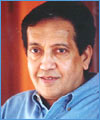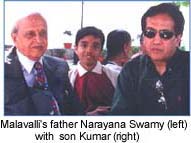His is not the typical Silicon Valley success story. In fact, when he first applied for a US visa in the early 1970s, it was rejected.
Today, Kumar Malavalli, 56, is the CTO and co-founder of Brocade Communications Inc, a Storage Area Networking company in the Valley, whose revenue for FY2000 was $ 329 million. His stake in the company has turned him into a multi-millionaire. No small achievement for a Mysore boy.
His story begins in 1972, when he left his newly-wedded wife Vijaya in Mysore and went to Dusseldorf, West Germany, to study industry electronics at the University of Hanover.
He overcame the first challenge, communication, by picking up German while staying as a boarder in Frau Weimmer’s house, and soon got work as a trainee engineer in the electronics department of the Mannesmann Rohrenwerk conglomerate. "This is where I learnt the practical aspects of applied engineering," he says.
Since getting a work visa in West Germany was next to impossible, he decided to move to the United States. However, his visa application was rejected, and in 1974, he opted for Canada, where he would spend the next 21 years.
His first exposure to communications technology was as a design engineer for ITT Communications, a subsidiary of the telecom giant ITT (which owned the Sheraton group of hotels, among other things). "However, the Association of Professional Engineers of Ontario of Canada required all engineers, who graduated from non-Canadian universities, to pass certification exams affiliated to the University of Toronto, in order to practise as professional engineers," he explains.
To prepare for the exam, he attended a few classes in communications technology, at the University of Toronto. This turned out to be an important step in his career.
In 1988, Malavalli got his big break in the fiber channel business when he represented his employer, Canstar -- a subsidiary of the French company Alcatel -- at the American standards setting body meet (the American National Standards Institute).
"At that time ANSI was developing standards for I/O (input/output) technology and storage was one of them. A group of 10 of us got together and felt we should come up with high performance data communications over long distance," Malavalli recalls.
There were no standards or products for SAN at that time. The group proposed moving storage from the computer and putting it in the network, increasing the distance and connectivity and increasing performance. The technology that was developed to meet these three points was named 'fiber channel' and was accepted by ANSI in 1988.
This heralded the birth of the SAN industry and set the stage for Malavalli's success.

After 1988, Malavalli was consumed with working on standards for data transfer, based on fiber channel technology, which included switching. While at Canstar, he developed and built a prototype switch based on this technology.
"But, it was a failure from a business point of view since it was not marketed properly," he recounts without rancor. However, Hewlett Packard, who Canstar was trying to convert into a customer, was interested and bought Malavalli's group from Canstar. This group became HP's Canadian network operations in 1993.
Working for HP proved to be disappointing for him. "HP was too slow and there was too much competition from other projects for money. Since we were in Canada, the distance was a problem for effective communications with headquarters," he says. "I clearly saw the potential for centralized storage and management and decided to do something on my own."
At this point, he started exploring ways to start a company dedicated to developing and marketing a fiber channel product. But "I was used to getting the door slammed in my face, when I went looking for money to build a switch product, to interconnect storage systems and servers, to create a high performance network. "Why 'storage networking?' was the inevitable question."
He struggled for more than two years to fund his dream, while he held a full-time position as a chief architect with HP's Canadian operation.
"Although Canada is well-known for its communications industry, the money is definitely not there," he says. "It was also a blessing in disguise that I did not get the funding then, since we were ahead of the market in 1992-1993. We thought the market was ready, but it was really not."
Meanwhile, thousands of miles away in Silicon Valley, Seth Neiman of Cross Point Ventures had developed an interest in the SAN industry. While researching the subject, Neiman got a call from Ed Fromeyer, a respected industrial analyst and a colleague of Malavalli's at HP.
Neiman wanted to meet him right away. Malavalli, who was thousands of miles away in Bangalore enjoying his summer vacation in the Garden City, caught the next plane to the Valley.
Their one-hour meeting, on a balmy evening in June 1995, dramatically altered the course of his life.
"I met Seth at the Gaylord Restaurant in the Stanford Shopping Center for dinner. Without any hesitation he agreed to fund us, all within an hour," recounts Malavalli. So, along with his partner Paul Bonderson, then the director of mass storage at Sun Microsystems, they founded Brocade Communications with $ 1.4 million in seed money.
The money came with strings attached. Brocade would have to be based in the Valley. Malavalli and his wife agreed without hesitation. This time, he left his daughter, Ranjini, behind in Toronto.

He was 51 years old and an immigrant all over again. But the second chapter of his life would turn out to be dramatically different from his secure but predictable corporate existence in Canada.
All of a sudden, money was not the focus anymore. Rolling out the product and getting the marketplace educated about SAN was. Subsequent rounds of funding exceeded $ 48 million. "We had to turn off the money tap since people wanted to fund us more. We had already taken more money than we required," Malavalli says.
When the company launched its IPO on May 24, 1999, its stock was priced at $ 19. By the end of the day, it closed at $ 50. Today, the stock trades in the 50s after three stock splits. The icing on Malavalli's cake came in February 2001 when Brocade was included in the prestigious Nasdaq-100 Index Tracking Stock.
Malavalli's stake in the company has made him a multi-millionaire, but he remains calm and unassuming, and looks more an academician than entrepreneur. Ranjini wants to start a VC company in Canada and he is helping her with it. He is also an angel investor and has invested in companies like Light Sand Communications, Astute Networks, Jasmine Networks and Myneton, among others.
But ask him where Brocade fits in the networking landscape, and the calm is replaced by anger. "Analysts are still not educated about SAN," he says in a frustrated tone. He vehemently disagrees with the pegging of Brocade in the conventional networking category.
"SAN is a different and fast growing sector and we would like analysts to recognize it as such. We provide interconnectivity for SAN. We make the switches that distribute the data. Although, this is similar to companies that provide interconnectivity in the LAN and WAN areas, SAN is characteristically different," he says.
The importance of storage becomes obvious given the exponentially increasing volume of critical information in the business sector. Typically, this information is stored in disk arrays and tape subsystems, connected to large, powerful servers. With the advent of SAN, storage devices are disconnected from the server and connected directly on the network. This provides centralized and scaleable storage shared by many servers and clients.
"If you lose a server, it is an annoyance factor. But if you lose the data you could lose your job or business," explains Malavalli. "What we are trying to do is transfer storage functions from the servers and put it in the networks. Servers should primarily be used for what they are meant -- serving applications -- not managing data."
Malavalli refuses to rest on his laurels. As head of the Brocade Technology User Group he holds monthly meetings with his customers and partners to find out their concerns, and works towards resolving them. He also chairs the ANSI/T11 technology committee, responsible for fiber channel technology standards.
A gadget-lover, Malavalli is partial to Canadian and German products. He relies on his trusted Canadian PDA-Blackberry for his digital communications. A Mercedes SL600 and BMW 750IL grace his garage. And for long distance travel, he is hoping to acquire a Canadian Bombardier jet by the end of the year. "This is a ten-seater with a range of 4,500 miles. In one hop I can go to Europe and in two hops to Asia," he says enthusiastically.
His parents who live in Mysore don't have to worry about money for the rest of their lives, he says. Last year, Vijaya and he took their extended family, of 38 members, across Rajasthan on the plush Palace on Wheels!
Malavalli has also been quietly donating money to education and health-related organizations. Along with Infosys chairman N R Narayana Murthy, he plans to donate a significant amount to their alma mater, the National Institute of Engineering in Mysore. He is also said to have donated close to a million dollars to the Gujarat earthquake relief fund.
Design: Lynette Menezes
Back to
top
Tell us what you think of this
report